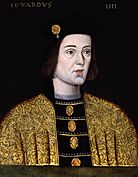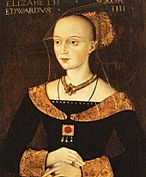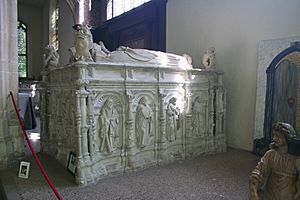Anne of York (daughter of Edward IV) facts for kids
Quick facts for kids Anne of York |
|
|---|---|
| Lady Howard | |
| Born | 2 November 1475 Westminster Palace, London, England |
| Died | 23 November 1511 (aged 36) |
| Burial | |
| Spouse | Thomas Howard (m. 1494/95; her death) |
| Issue | Thomas Howard |
| House | York |
| Father | Edward IV of England |
| Mother | Elizabeth Woodville |
Anne of York (born 2 November 1475 – died 23 November 1511) was the fifth daughter of King Edward IV of England and his wife, Elizabeth Woodville.
After her father died, her uncle Richard III took the throne. Anne, who was about eight years old, was declared not a rightful heir, along with her brothers and sisters. Her mother worried for their safety. She moved them to Westminster Abbey, where they found a safe place to stay for about a year.
Later, King Richard III promised not to hurt his brother's family. So, Anne and her older sisters moved to the royal court. When Richard III was killed, Henry Tudor became the new king. He made a law that said Edward IV's children were rightful heirs again.
Henry VII married Anne's oldest sister, Elizabeth. This made Anne an important person for alliances with other countries. A marriage was planned for her with a Scottish prince. But in 1488, the prince's father, King James III, died. The marriage talks stopped and never started again.
In 1495, Anne married Thomas Howard. He had wanted to marry her since Richard III's time. Anne had poor health and died around age 36. Sadly, all her children died young.
Contents
Early Life and Family
Anne was born on 2 November 1475 at the Palace of Westminster. She was the seventh of ten children born to King Edward IV of England and Elizabeth Woodville.
Anne had six sisters. Only four of them lived to be adults. These were Elizabeth, Cecily, Catherine, and Bridget. Her sister Mary died at age 14. Margaret died when she was a baby.
Anne also had five brothers. Three were full-blooded brothers: Edward V, Richard, and George. Two were half-brothers from her mother's first marriage: Thomas and Richard Grey.
None of Anne's full-blooded brothers lived to be adults. George died when he was about two years old. Edward V and Richard, known as the Princes in the Tower, disappeared in 1483. This happened during the rule of their uncle, King Richard III.
Anne's grandparents on her father's side were Richard of York, 3rd Duke of York and Cecily Neville. Her mother's parents were Richard Woodville, 1st Earl Rivers, and Jacquetta of Luxembourg.
Anne was baptized at Westminster Abbey soon after she was born. She was named after her aunt Anne of York and her great-grandmother Anne de Mortimer. The name "Anne" was new for the English royal family. Anne was the first daughter of a king to have this name.
Marriage Plans for Anne
In 1479, when Anne was almost four, her father King Edward IV started talks. He wanted to arrange a marriage for Anne with Philip. Philip was the son of Maximilian of Austria. Philip was second in line to the throne of the Holy Roman Empire.
This marriage idea came from Maximilian. England liked the idea because it would bring political benefits. Philip's mother, Mary of Burgundy, was very rich and powerful. Also, her stepmother was Edward IV's sister, Margaret of York.
In 1480, the agreement became more formal. Anne was promised a large sum of money as security. Maximilian agreed to pay Anne money each year once she turned 12. This was the age when she could agree to marry.
He also promised her land in Artois once she arrived at his court. If Anne refused the marriage, Edward IV would have to pay a large sum. In return, Maximilian promised to help England against France. The talks finished on 5 August 1480.
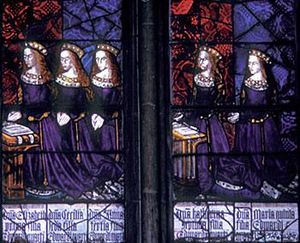
Life Under Richard III
Anne's planned marriage to Philip of Austria continued until her father died in 1483. Edward IV's death caused a big political problem. This changed everything for the queen and her children.
Anne's older brother, Edward V, became king. But his uncle, Richard, Duke of Gloucester, captured him. This happened while Edward V was traveling to London. Anne's uncle, Anthony Woodville, 2nd Earl Rivers, and half-brother, Richard Grey, were also arrested.
Edward V was taken to the Tower of London to wait for his coronation. His only brother, Richard, joined him there later. The queen and her other children, including Anne, found safety in Westminster Abbey.
On 22 June 1483, Edward IV's marriage was declared illegal. All of his children were said to be illegitimate by a law called Titulus Regius. This meant they lost their right to the throne and all their titles. A few days later, Anne's uncle Anthony Woodville and half-brother Richard Grey were executed.
On 6 July, Richard of Gloucester became King Richard III. Soon after, Anne's brothers in the Tower disappeared. Richard III ordered guards to watch Westminster Abbey. He feared Anne's older sisters might escape and try to overthrow him.
On Christmas Day 1483, Henry Tudor promised to marry Anne's older sister Elizabeth. If that was not possible, he would marry Cecily. This promise was made in Rennes Cathedral. But Henry's rebellion, led by the Duke of Buckingham, failed.
Return to Court
After the rebellion failed, Richard III talked with his brother's widow. On 1 March 1484, the king publicly swore he would not harm Edward IV's daughters. He promised they would not be put in prison. He also said they would live in "respectable places" and marry "men of noble birth." They would also receive land with a good income.
The princesses were happy to leave Westminster Abbey. They went to live under the care of their "gracious uncle." He gave them rooms in his palace. A historian named Edward Hall wrote that Richard III "made all the daughters of his brother solemnly arrive at his palace." He treated them kindly so they would forget their past troubles.
Soon after the princesses arrived at court, the king looked for husbands for them. For Anne, he chose Thomas Howard. Thomas was the son and heir of the 1st Earl of Surrey. This showed the king's favor to the Howard family. Anne and Thomas were engaged in 1484. But the king died before the marriage could happen.
Life Under Henry VII and Henry VIII
In August 1485, Richard III died at the Battle of Bosworth. Henry Tudor became the new king, Henry VII. He had promised to marry Anne's older sister, Elizabeth.
When Henry VII became king, he canceled the Titulus Regius act. This act had taken away the titles and rights of Edward IV's children. The act and all its copies were removed from official records.
When Elizabeth of York married the new king, Anne was only twelve. She and her other sisters lived at court. Their oldest sister, the Queen, looked after them. Anne started to take part in royal events.
She attended the christening of her first nephew, Arthur, Prince of Wales, in 1486. Anne carried the baptismal veil for the prince. She also played a similar role at the christening of her niece Margaret in 1489. Anne took part in Easter, Pentecost, and Christmas celebrations at Henry VII's court.
New Marriage Plans
Soon after becoming king, Henry VII made marriage plans for his wife's family. He wanted an alliance with Scotland. The king planned for his mother-in-law, Elizabeth Woodville, to marry the widowed King James III. He also planned for his heir, James, Duke of Rothesay, to marry one of Edward IV's daughters.
Cecily was already engaged. Catherine was to marry the prince's younger brother. This left Anne and her youngest sister, Bridget. Bridget planned to become a nun. So, Anne was the only choice. But James III died in 1488, and all talks stopped.
In 1488, on St George's Day, Anne was with her sister the Queen. She wore a scarlet velvet robe. She rode a white horse with a golden saddle cloth. The cloth had white roses, the symbol of the House of York.
The next time Anne is mentioned is when her mother died in June 1492. Anne was at her mother's bedside in Bermondsey Abbey. Her mother had spent her last five years there. Anne led the mourners at her mother's funeral. Queen Elizabeth could not attend because she was expecting a child.
Anne and her younger sisters, Catherine and Bridget, went with the Queen's body to Windsor Castle. On 13 June, Elizabeth Woodville was buried next to Edward IV in St George's Chapel.
Anne's Marriage
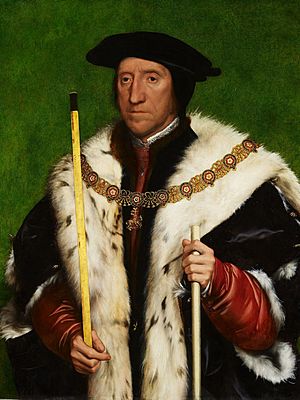
When Anne was old enough to marry, Queen Elizabeth looked for a suitable husband for her. The Queen thought of Thomas Howard, the son of the 1st Earl of Surrey. Richard III had already planned for Anne to marry him.
Anne knew Thomas since childhood. His father served King Edward IV. The Howard family supported the House of York during the Wars of the Roses. Because of this, under Henry VII, Thomas's father was imprisoned in the Tower in 1485. He lost his rights and titles for a time.
Later, he was freed and got back most of his lands and rights. He was called to court and given a position close to the king. However, he did not get back all his titles. He received the title of Earl of Surrey again. But the title of Duke of Norfolk was only given to him in 1514. Thomas was about two years older than Anne.
The Queen agreed that the Howard family was noble enough for a royal marriage. So, on 4 February 1495 (or 1494), Anne and Thomas Howard were married. The wedding was held in Westminster Abbey. The celebrations took place at the Palace of Placentia. The King and Queen attended the wedding.
Anne was supposed to receive a dowry of 10,000 marks from her father. But the newlyweds did not receive this money. Instead, the Queen ordered that they receive payments of £120 per year. This money was for Anne's living costs, her servants, and her horses. This payment was also to ensure Anne was not fully dependent on her husband.
The groom's father had only part of his family's estate. There was no suitable home for a royal woman there. So, Anne and Thomas were allowed to use estates belonging to the Duke of York and the Marquess of Dorset. These were Anne's nephew and half-brother. The King also gave Anne another £26 per year from royal lands.
After the wedding, Anne rarely visited the royal court. One reason might have been her poor health. Not much is known about her life during this time. Court records show that in 1502–1503, Queen Elizabeth paid for silk for Anne's dress. In 1502, the Queen also added money to Anne's yearly expenses. She also gave money to Thomas Howard for his wife's food.
In 1503, the Queen died. Anne attended her funeral, but as a spectator, not a main mourner. Her sadness at losing her sister was so great that she could not stay for the whole ceremony.
Anne's marriage to Thomas Howard was difficult. All their children died before them. The exact number and names of their children are not fully known. Some records suggest four children. Only one son, named Thomas, lived long enough to be baptized. This son Thomas was born around 1496 and died in 1508. Other accounts mention a son and two daughters who died very young. Anne's son was buried in the Howard family tomb in Lambeth.
Later Life and Death
Only a few records exist from Anne's last years. On 23 March 1510, her nephew King Henry VIII gave Anne and her husband a property in Stephenheath. On 22 November, the king gave Anne more lands. This was to make up for lands she claimed through her great-grandmother, Anne de Mortimer. These lands included a castle and manor in Wingfield and other properties in several counties.
The exact date of Anne's death is not known for sure. Some historians say she died after 22 or 23 November 1511, but before 1513. Other sources give 23 November 1511 as an approximate date. Records show that Anne is not mentioned in a law about the Howard family in February 1512. Also, Thomas Howard's possible marriage to Lady Elizabeth Stafford was discussed around that time. This suggests Anne had died by February 1512.
Anne was first buried at Thetford Priory. After the Reformation, Anne's husband asked the king to keep the Priory as a church. This was because Anne, the king's aunt, and Henry VIII's son Henry FitzRoy were buried there. But the king did not agree.
Henry VIII allowed people to move the remains of their relatives from dissolved monasteries. So, Thomas Howard moved Anne's remains to the Church of St Michael the Archangel, Framlingham. He ordered a grand tomb for her. He planned to be buried there too, which happened in 1554. Because Anne was of royal blood, Thomas Howard was buried to her left. This was unusual, as husbands were usually buried to the right.
Images for kids
-
Portrait of Edward IV, now at the National Portrait Gallery, London, c. 1597 – 1618
-
Portrait of Elizabeth Woodville from the collection of Queens' College, Cambridge, c. 1471


